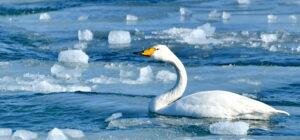The Whooper Swan (pronounced hooper), Cygnus cygnus, is a large Northern Hemisphere swan. It is the Eurasian counterpart of the North American Trumpeter Swan. An old name for the Whooper Swan is ‘Elk’; it is so called in Francis Willughby and John Ray’s Ornithology of 1676.
The Whooper Swan is similar in appearance to the Bewick’s Swan. However, it is larger, at a length of 140–165 cm (55–65 in) and a wingspan of 205–275 cm (81–108 in). Weight typically is in the range of 7.4–14 kg (16–31 lb), with an average of 9.8–11.4 kg (21.6–25.1 lb) for males and 8.2–9.2 kg (18.1–20.3 lb) for females. The verified record mass was 15.5 kg (34 lb) for a wintering male from Denmark. It is considered to be amongst the heaviest flying birds. Among standard measurements, the wing chord is 56.2–63.5 cm (22.1–25.0 in), the tarsus is 10.4–13 cm (4.09–5.1 in) and the bill is 9.2–11.6 cm (3.62–4.57 in). It has a more angular head shape and a more variable bill pattern that always shows more yellow than black (Bewick’s Swans have more black than yellow).
Distribution and behaviour
Whooper Swans require large areas of water to live in, especially when they are still growing, because their body weight cannot be supported by their legs for extended periods of time. The whooper swan spends much of its time swimming, straining the water for food, or eating plants that grow on the bottom.
Whooper Swans have a deep honking call and, despite their size, are powerful fliers. Whooper Swans can migrate hundreds or even thousands of miles to their wintering sites in southern Europe and eastern Asia. They breed in subarctic Eurasia, further south than Bewicks in the taiga zone. They are rare breeders in northern Scotland, particularly in Orkney, and no more than five pairs have bred there in recent years. This bird is an occasional vagrant to the Indian Subcontinent and western North America. Icelandic breeders overwinter in the United Kingdom and Ireland, especially in the wildfowl nature reserves of the Royal Society for the Protection of Birds and of the Wildfowl and Wetlands Trust.
Whooper Swans pair for life, and their cygnets stay with them all winter; they are sometimes joined by offspring from previous years. Their preferred breeding habitat is wetland, but semi-domesticated birds will build a nest anywhere close to water. Both the male and female help build the nest, and the male will stand guard over the nest while the female incubates. The female will usually lay 4–7 eggs (exceptionally 12). The cygnets hatch after about 36 days and have a grey or brown plumage. The cygnets can fly at an age of 120 to 150 days.
Influence
Whooper Swans are much admired in Europe. The Whooper Swan is the national bird of Finland and is featured on the Finnish 1 euro coin. The Whooper Swan is one of the species to which the Agreement on the Conservation of African-Eurasian Migratory Waterbirds (AEWA) applies.
The global spread of H5N1 reached the UK in April 2006 in the form of a dead Whooper Swan found in Scotland.
Musical utterances by Whooper Swans at the moment of death have been suggested as the origin of the swan song legend.





